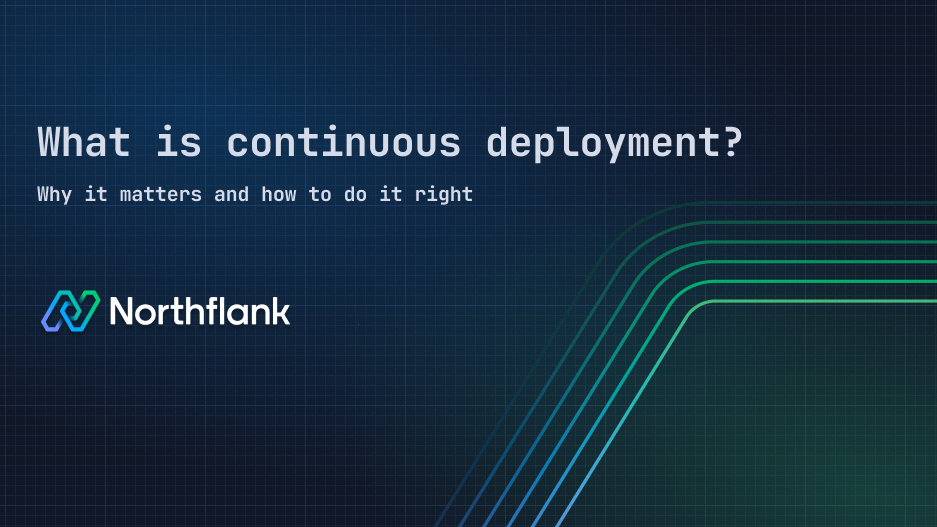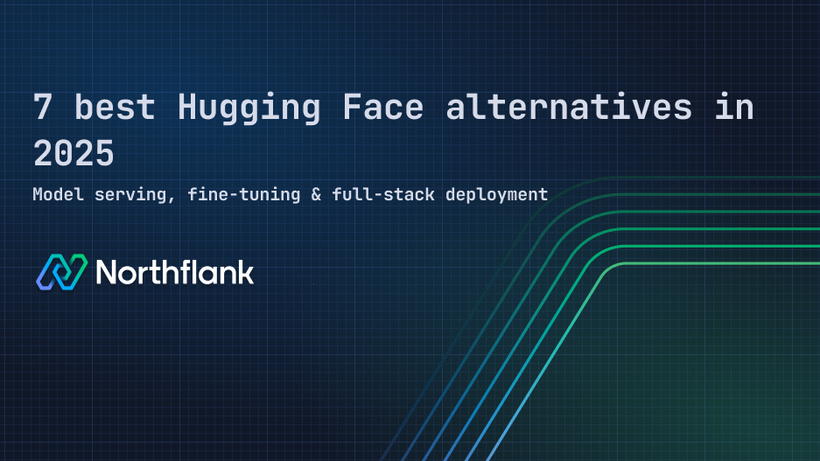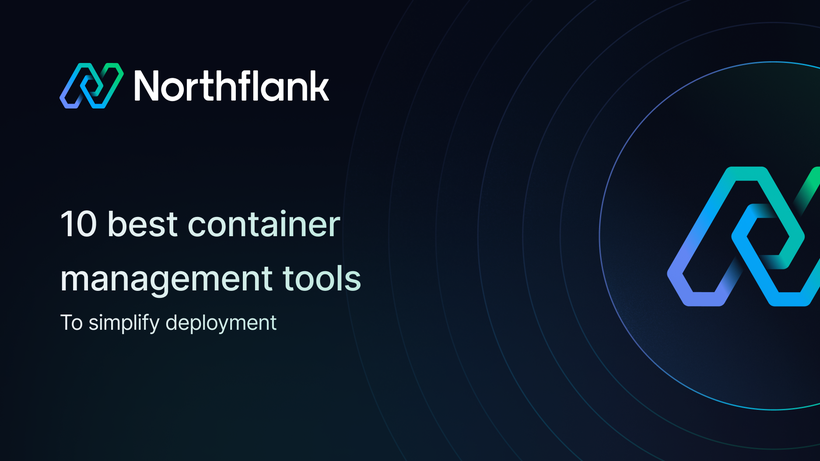

What is continuous deployment? Why it matters and how to do it right
Continuous deployment is the engineering practice of automatically releasing code changes to production as soon as they pass all quality gates in your CI/CD pipeline.
When was the last time you shipped code that you knew would make it to production without any last-minute failures?
If you’re like most of us, you’ve seen the tension between moving fast and making sure things don’t break in production. Continuous deployment has been on the radar for a while, but it’s more than a checkbox on a pipeline; it’s about giving your team confidence that your software is always in a deployable state.
In the next few minutes, you’ll see how continuous deployment works, where it fits in your pipeline, and why it’s become a standard for modern engineering teams. I’ll also share what you can expect when you’re moving past manual deployments and how tools like Northflank can make the transition a lot easier.
See some of the tools teams are using for continuous deployment today:
- Northflank – Unified platform to build, deploy, and promote across environments without scripting or manual integration.
- Argo CD – GitOps-based delivery controller for Kubernetes clusters.
- Spinnaker – Multi-cloud delivery platform with deployment strategies.
- Harness – CD-as-a-service platform with built-in approval gates and policy controls.
- GitHub Actions – CI-first with flexible deployment workflows using custom YAML.
After you’ve got your builds passing tests and your code is ready for production, there’s one more question to answer: how does it get there? That’s where continuous deployment comes in.
Continuous deployment is the engineering practice of automatically releasing code changes to production as soon as they pass all quality gates in your CI/CD pipeline.
Okay, so this is how it works:
- You merge a change
- CI runs the tests and builds,
- And if everything passes, it’s pushed live
Meaning no manual approvals or extra steps.
Now, your previous approach might have involved someone on your team manually triggering the deployment, but with continuous deployment, every validated change goes live automatically. This way, your team can merge a change, watch it flow through the pipeline, and know it’s already in the hands of users.
Let’s visualize how continuous deployment begins once code is validated, and how it’s different from simply finishing a CI/CD process.

It’s easy to confuse continuous deployment with continuous delivery, so let’s clear that up. Both aim to keep every change in a deployable state, but continuous delivery still requires someone to push the final deploy button. Continuous deployment removes that step entirely, meaning every validated change goes live on its own.
If your team is focused on stability and speed, continuous deployment removes bottlenecks and shortens the feedback loop between development and production. You can ship small, frequent updates with confidence, knowing you’re not relying on manual gates that slow things down.
So let’s talk about why your team should care about continuous deployment in the first place.
If you’re leading engineering or platform teams, this isn’t just another automation step. It’s what turns your tested builds into live updates, automatically and without constant oversight. You get faster feedback on every change, easier incident fixes, and no more guessing about what’s live in production.
If you’re an engineer, continuous deployment clears the bottlenecks. Once your tests pass, your code goes live, no waiting on approvals or chasing down someone to click deploy. You merge, it ships, and you’re already on to the next task.
So, if you use this approach, you’ll notice the following impact:
- Shorter feedback loops – Your changes reach users in minutes, not days, so you can learn faster and iterate quickly.
- Better incident response – Smaller, continuous changes mean easier debugging and simpler rollbacks.
- Fewer delivery obstacles – No more last-minute deploy scripts or hidden steps, everything happens as part of your pipeline.
Continuous deployment isn’t about moving fast for its own sake; it’s about closing the gap between your team’s work and the real world, so you can keep building with clear visibility and minimal manual overhead.
Now that you know why continuous deployment matters, let’s talk about the day-to-day challenges you’re likely to face.
Continuous deployment isn’t simply about turning on auto-deploy and calling it a day. It brings new layers of complexity that can surprise even experienced teams.
Let’s see what usually gets complex:
- Testing complexity – Unit tests and CI might be thorough, but real-world delivery depends on integration tests, environment-specific checks, and sometimes load testing.
- Config differences – Staging and production often fall out of sync when configuration isn’t managed as code.
- Deployment failures – Even if your app works in one environment, an edge case can break production when changes move too quickly.
- Visibility gaps – If you can’t trace what’s live and what’s pending, fixing failures takes longer.
So, what can you do?
-
Automated rollback strategies
Let’s say, for instance, a bad deploy goes live and users start seeing errors. If you’ve automated your rollbacks, maybe using Git tags, container rollbacks, or versioned artifacts, you can revert quickly, without manual hotfixes.
-
Config management via GitOps
Managing config as code keeps your environments aligned. Tools like ArgoCD or Flux CD let you version secrets, API endpoints, and environment-specific settings. So even if your app evolves, your deployment config doesn’t lag behind.
-
Monitoring and tracing deployments
When a deploy fails, you’ll want immediate answers. Observability tools like Prometheus, Grafana, or Datadog can help you trace exactly what changed, which commits shipped, and which environment it landed in.
-
Defining clear ownership boundaries
Ownership matters, especially as teams grow. Make it explicit who owns the pipeline logic, who monitors delivery, and who’s on call when something breaks. That way, no one is left guessing.
Continuous deployment is a valuable engineering practice, but only when your team has the visibility and control to catch issues early and recover fast.
Up next, let’s see how modern platforms can make this easier so you’re not reinventing the wheel for every deploy.
You may have asked this question already. Platforms like Northflank help you handle the complexities of continuous deployment head-on. Let’s see how.
Northflank’s preview environments let you test changes automatically before they go live. Whenever you push to a branch or open a pull request, Northflank spins up an isolated preview environment. This environment can mirror production resources or remain isolated, and you can set rules for how long it lives or when it’s created (e.g., within your team’s working hours).
Preview environments reduce the risk of broken deploys. They give your team the chance to validate real-world behavior and catch configuration mismatches early.
See Northflank’s preview environment template creation form, where you can configure triggers and naming conventions for safe, repeatable deploys:
 Create preview environments in Northflank’s visual template editor to validate changes before they go live.
Create preview environments in Northflank’s visual template editor to validate changes before they go live.
Deployments in Northflank start and end with Git-driven workflows. Builds are triggered automatically by commits or pull requests, so you can track exactly which commit is live in each environment. No more guessing what’s deployed.
Git-based triggers keep your environment updates in sync with your code history. Rollbacks or forward-only updates remain reproducible because every deployment ties back to a commit.
See how Git-based build triggers in Northflank’s service UI manage automatic deployments:
 Northflank’s Git-based triggers ensure deployments stay tied to specific commits, keeping everything consistent and traceable
Northflank’s Git-based triggers ensure deployments stay tied to specific commits, keeping everything consistent and traceable
If a release goes sideways, Northflank’s rollback features let you revert to a known good state. You can roll back the release pipeline itself (returning it to a previous stage) or roll back the configuration for a full environment recovery.
Rollbacks ensure you don’t waste time fixing broken releases; simply restore and investigate later. Rollback logs give you the full history of what was live and when.
See how Northflank’s rollback view helps teams revert broken releases to a safe state:
 Northflank’s rollback logs give you a clear view of past deployments and help you restore a working environment in seconds.
Northflank’s rollback logs give you a clear view of past deployments and help you restore a working environment in seconds.
Northflank’s secure secret management and shared resources let you safely inject environment variables and reuse database or storage configurations across environments.
No more environment inconsistencies because your preview, staging, and production environments can share the same secrets and data sources without risk.
Secrets are managed in a dedicated group and are only visible where they’re needed.
See how Northflank’s secret group setup ensures secure and consistent environments:
 Securely manage secrets and reuse them across your environments to avoid manual reconfiguration
Securely manage secrets and reuse them across your environments to avoid manual reconfiguration
Every build and deploy in Northflank is fully traceable. Northflank provides extensive logging capabilities for builds, deployments, running containers, and environment lifecycles. You can:
- Search and filter logs by commit, tag, or error message
- View logs across multiple containers or jobs
- Tail live logs in real-time as new entries appear
Full observability and traceability mean you’ll always know:
- Which commit triggered a build
- When a deployment happened
- Who updated a config or secret
This comprehensive logging experience ensures fewer surprises and faster fixes, because every deployment’s story is right there in the logs.
See how Northflank’s live build logs help your team stay informed and debug quickly:
 Detailed logs from builds and deployments help your team understand every step of your environment’s lifecycle.
Detailed logs from builds and deployments help your team understand every step of your environment’s lifecycle.
Okay, now you’ve seen how tools like Northflank can handle the complexities of continuous deployment, let’s answer some common questions teams have when they’re weighing the decision to go all-in.
1. What’s the difference between continuous delivery and continuous deployment?
Continuous delivery means your code is always ready to deploy, but it still requires a manual step to push it live. Continuous deployment takes that last step automatically; every change that passes testing goes straight to production.
2. What is the difference between continuous deployment and release?
A deployment is the act of putting new code into production. A release means the change is available to users. With continuous deployment, deployments and releases are often one and the same.
3. How does continuous deployment work with GitOps?
GitOps uses Git as the single source of truth for environment configurations. Continuous deployment slots in by automatically applying those Git-based changes to your environments as soon as they’re committed.
4. When to use continuous deployment?
It’s best for teams that can test quickly and want rapid feedback loops. If you have mature testing and observability in place, continuous deployment speeds up delivery and tightens that loop.
5. Is continuous deployment a good idea for every team?
Not always! If your team is still working out testing or has compliance constraints, continuous delivery (with manual approvals) might be a better fit.
6. Is continuous delivery the same as DevOps?
No. DevOps is a broader culture of collaboration and shared responsibility, while continuous delivery is a specific practice within that culture.
7. How does continuous deployment help with scalability and environment management?
By removing manual bottlenecks and using automated environment creation (like Northflank’s previews), continuous deployment makes it easier to spin up and scale down environments as your needs change.
I know that adopting continuous deployment isn’t something a single engineer can do in isolation. It’s a team-level decision that needs buy-in from platform teams, app developers, and even compliance stakeholders.
I encourage you to start small. Try continuous deployment on low-risk services first. Use early incidents as opportunities to learn, not reasons to shy away. Iterate on your processes, strengthen testing, and build observability as you scale.
If you’re looking for a platform that integrates these pieces for you, from environment previews to automatic rollbacks, Northflank is designed to help. It’s built to give you the control and safety nets you need, without the operational overhead of integrating separate tools.
Want to see how it fits into your stack? Get started with Northflank.

